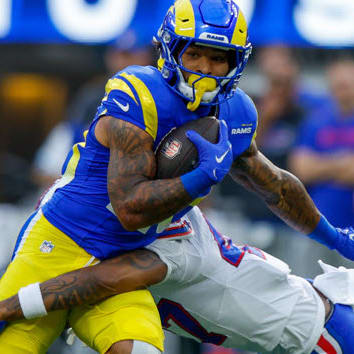This article is a top-10 ranking for the 2023 rookie tight end class as it goes into the combine. You can also read the QB top 8 here, the RB top 20 here, and the WR top 25 here.
- Michael Mayer, Notre Dame (6-4, 260)
Many are quick to note that Mayer is heavy for his frame and lacks obvious standout speed, which then leads to concerns about whether he can continue to catch passes at a standout level in the NFL. Ignore those. Mayer might be huge, and perhaps that hugeness is even at the expense of his speed in some sense, but Mayer is still clearly a standout athlete overall and especially when adjusting for frame.
Not all big tight ends are blockers. Indeed, some of the best tight ends of recent memory are big by tight end standards – Rob Gronkowski, Travis Kelce and Mark Andrews would each apply – so it's important to remember that Mayer's build is a positive and not a negative, even for his fantasy projection. Mayer produced while lining up all over the place at Notre Dame, which bodes very well for his NFL projections. He will stay on the field for three downs and he's a credible target candidate from almost any formation. If the team is calling big personnel, he's involved. If the team is playing catch-up, he's involved. Don't overthink production like this – it almost never happens.
From ages 19 through 21 Mayer caught 180 passes for 2,099 yards and 18 touchdowns on 265 targets -- good for a catch rate of 67.9 percent at 7.9 yards per target. While the efficiency might not jump out at a glance, nearly 68 percent completed at nearly 8.0 yards per target is excellent efficiency for a tight end carrying the volume Mayer did. In 2022, for instance, Mayer not only led Notre Dame in all receiving categories but more specifically produced 33.7 percent of their receiving yards and 40.9 percent of their receiving touchdowns. You almost never hear of tight ends producing more than 1/3 of a team's receiving production. His absolute worst-case career outcome is something like Jermaine Gresham.
Projected round: 1 (Top 20)
2. Dalton Kincaid, Utah (6-4, 240)
Kincaid is fairly interesting, but some estimations of him might be a bit over the top. More specifically, if Kincaid is considered as a first-round pick as some advocate then he might prove a disappointment. Kincaid is small for a tight end but doesn't have obvious standout athleticism to offset that. When you're barely bigger than a wide receiver you need to be similarly athletic to one. Not just that, but maybe most importantly, Kincaid's production simply isn't as good as it looks at a glance. That's both because Kincaid is old for his level and because he only broke out with monster 2022 production after fellow Utah tight end Brant Kuithe suffered a season-ending injury in the fourth game. In 2021, at the already high age of 22, Kincaid was highly efficient but only caught 36 passes in 14 games. For a 22-year-old NFL prospect tight end a high standard is warranted with their production, and instead Kincaid saw Kuithe catch 50 passes for 101 more yards.
It would have been reassuring if Kincaid had produced a greater share of Utah's receiving yardage in 2021, if only because it would make his 70 receptions for 890 yards and eight touchdowns in 2022 more convincing. Kincaid remained highly efficient even with the volume increase, but it's not easy to give him full credit for it since he turned 23 in October and would project for less volume if Kuithe hadn't gotten hurt. Then again, Kincaid's stats were truly dominant at Utah, and he posted a similarly strong box score for the University of San Diego as an age-20 player in 2019. If Kincaid stands out in athletic testing it will be difficult to doubt him at that point, because his production is definitely more strong than not.
Projected round: 2
3. Sam LaPorta, Iowa (6-4, 249)
You probably won't see it much but there's a case to make that LaPorta is as good or better than Kincaid. For fantasy purposes there's no reason to suppose so – by all accounts Kincaid will go first of the two – but LaPorta is uncommonly polished as a volume pass catcher yet might have upwards of 10 pounds on Kincaid at no expense to LaPorta's speed. LaPorta was quietly an exceptionally productive receiver at Iowa the last two years, leading Iowa in all receiving categories while producing at an efficiency level well above the Iowa baseline.
Projected round: 2
4. Darnell Washington, Georgia (6-7, 270)
Washington might be a more interesting player for real life football purposes than fantasy football. He reportedly can run a sub-4.7 40 at an offensive lineman-like size, which can put a defensive coordinator in a tough spot when they try to figure out what personnel to call for. If you ignore Washington as a pass-catching threat by countering him with a defensive end in a five-man front then you risk giving up a big play down the seam or toward the sideline. If you try to preempt that outcome by countering him with, say, a sub-250 pound linebacker then you risk getting ran over until you switch him out.
But with so much of Washington's on-field threat expressed in the form of blocking advantages, it almost necessarily dictates that Washington line up at reps that trend toward the periphery of passing game structure. Washington could do a lot of damage on a per-target basis, perhaps both yards per target and touchdown percentage, but for Washington to get target volume his blocking abilities are almost a hindrance. It's easier to draw a target running a route from the slot than it is from in line with a 280-pounder lined up over you, so while it's a win for Washington to draw that matchup it's not a benefit that shows up in fantasy scoring.
The way Washington would be particularly interesting is if he ends up on a team with a quarterback who throws a lot of touchdowns. Again, while target volume is pretty much not on the table for Washington, he is absolutely a conventional red-zone and big-play threat on a per-target basis if the defense isn't careful.
Projected round: 2
5. Payne Durham, Purdue (6-5, 258)
Durham is unlikely to test especially well at the combine but if he does he could prove more interesting than most assume in the meantime. At 6-foot-5, 258 pounds he's densely built, and it's not often you see someone with his frame draw as many targets as Durham did at Purdue. While he strictly appears an underneath target -- not surprising given how heavy he is -- Durham drew targets at a fairly rapid pace, which might indicate that he gets open underneath better than most tight ends generally, and certainly as far as his weight class goes.
In his last three seasons (29 games) Durham saw 167 targets, catching 117 for 1,193 yards and 17 touchdowns. That's a catch rate of 70.1 at 7.1 yards per target – solid chain-moving work at the least, and the 17 touchdowns are a solid pace too. Sometimes possession specialists struggle to score touchdowns due to their general inability to create separation, but for Durham that hasn't been the case.
Projected round: 2-4
6. Josh Whyle, Cincinnati (6-7, 260)
Whyle almost might be too tall, or at least too skinny for his height, and normally you worry about a guy like that when he gets caught in a phone booth. Whyle might be unusually athletic for someone of his frame, though, and if he's explosive enough then it could help to offset any leverage difficulties he might face. If Whyle can confirm standout athleticism at the combine he could project surprisingly well as a pass-catching threat in the NFL.
Projected round: 3-4
7. Luke Musgrave, Oregon State (6-6, 255)
Musgrave could move up for me if he tests well at the combine, because there are hints of standout skill set in his production and tape. It's good to see that as a tall tight end he's safely over 250 pounds – it alleviates concerns about whether he'll be able to bully as a route runner when he otherwise can't create separation. He's probably better than former teammate Teagan Quitoriano, who went in the fifth round of last year's draft.
Projected round: 3-4
8. Cameron Latu, Alabama (6-4, 248)
Latu is not big by tight end standards, but he is a size bigger than Kincaid or Will Mallory, both of whom are candidates to weigh in under 240 pounds. Latu is expected to weigh in more around 250, in which scenario he'd be approaching 'average' tight end build. Although he's bigger than Kincaid and Mallroy, Latu might test the best of the three in athletic testing. Latu was formerly a blue chip recruit as an edge defender, so if he turns out to be very athletic it shouldn't be truly surprising. Unfortunately it's not clear what his strong points might be beyond that. It's doubtful that he's fully developed three years into playing tight end, so hopefully he'll demonstrate standout tools in athletic testing. Latu requires some projection and it's easier to project a player with plus tools to work with.
Projected round: 5-6
9. Will Mallory, Miami (FL) (6-4, 239)
In the good-case scenario Mallory ends up in the same genre of tight end as Kincaid and Greg Dulcich; one who is barely a tight end at all and provides their theoretical value by being able to pick up functions that might overlap with those of wide receivers. We'll see how the other two do in the NFL, but to even vaguely make sense in theory this category of tight end requires standout athletic testing. Similarly, Mallory needs to show standout speed and quickness – the sort sufficient for WR-like functions – because he's not going be a useful base player for inline functions at his weight.
If Mallory can't demonstrate athleticism of that sort then it risks negating his otherwise convincing skill set. Mallory's pass-catching production at Miami was totally good and a solid indication of an NFL-viable skill set as a route runner, but he needs wheels of a certain grade to project as more than a rotational tight end.
Projected round: 4-6
10. Davis Allen, Clemson (6-6, 246)
Allen was a good player for Clemson and a standout starter over the last three years, but it's not clear whether his game will translate to the next level. Allen's utility to Clemson seemed mostly to just be the fact that he's punctual and reliable on a tall frame, which was enough for their purposes. In the NFL he'll be skinny for his height but with no obvious athletic tools to offset that, which might make him little more than a safety checkdown sort of target as a route runner.
Projected round: 5-6






































